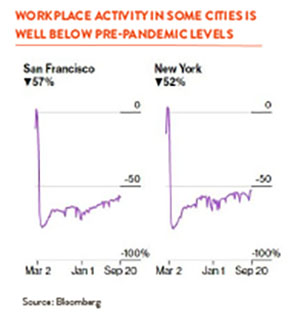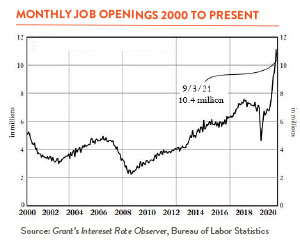According to Google’s Community Mobility data, we are visiting supermarkets and drugstores at the same level we did before the pandemic, and we are almost back to pre-pandemic levels when it comes to visiting restaurants, shopping centers, and recreational spots like theme parks, movie theaters, and museums. But the one place we still are not returning to is our workplaces. We still are not back in the office.
Google aggregates data on all the places people visit daily (if their “Location History” is turned on), then compares this to our baseline activity in early 2020 before COVID changed everything. As of November 8, across the entire U.S., trips to workplaces were 22% below the baseline.
These data fluctuate day to day, and there are big regional differences (on Google, you can look at patterns around the world, from Afghanistan to Zimbabwe). Workplace activity in big cities like San Francisco and New York is well below what it used to be (see charts below). Bloomberg reported that only 21% of San Francisco office workers had returned as of September 22, and even though tech job listings are back to pre-pandemic levels, 20% are for fully remote work.

More workers are insisting on staying remote — and it does look like workers have the upper hand. Unfilled job openings are at a historic high, and as Jim Grant recently wrote, “The bidding frenzy for employable people resembles the stampede for houses or non-fungible tokens.” Yes, employees are a hot asset with newfound bargaining power to demand more – or quit. You can call it the “Great Resignation,” the “Great Reshuffling,” the “Great Reassessment,” or for the less gentle, the “take-this-job-and-shove-it” movement. No one really knows why people aren’t returning to the office — or to work at all. But if we’re fine going to shops or restaurants, it’s probably more than COVID holding us back.

Savings are high. As Anne points out on page 4, checking account balances are 50% higher than in 2019. More families can make do with one wage earner instead of two. And more people are striking out on their own. New business formation reached a record high in mid-2020 and is 50% higher today than before the pandemic. But perhaps more than anything, it’s that after a year at home reflecting on what is really important in life, many have concluded that working in so-so jobs is not it.